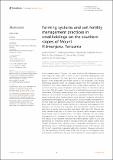Farming systems and soil fertility management practices in smallholdings on the southern slopes of Mount Kilimanjaro, Tanzania

View/
Date
2024-02-16Author
Mhoro, Lydia
Meya, Akida
Amuri, Nyambilila
Ndakidemi, Patrick
Mtei, Kelvin
Njau, Karoli
Metadata
Show full item recordAbstract
In the northern part of Tanzania, the slopes of Mount (Mt.) Kilimanjaro are the
most important areas, both in terms of socio-economic development and
ecological succession. The main agricultural systems in the area are banana-
based (in the highlands) and maize-based (in the lowlands), with strong
interlinkage between them via residual transfer from the lowlands to the
mountains. This study assessed the soil fertility status between the two
contrasting farming areas of highland and lowland farms in Hai district along
the slopes of Mt. Kilimanjaro. To achieve this, smallholder farmers along the slope
[from above 1000 meters above sea level (m.a.s.l) banana-based down to maize-
based, i.e., less than 1000 m.a.s.l] who practice crop residual transfer from maize-
based to banana-based farming systems were selected. Qualitative information
regarding the demographics, farming practices, and soil fertility management in
the two areas were gathered using a semi-structured questionnaire. Soils from
both areas (highland and lowland farms) were collected and analyzed in the
laboratory for the key soil properties. The demographic results show that
agriculture is mostly done by adults and elders (>40 years old). Manure was
most commonly reported to be used in the highlands, while inorganic fertilizers
were mainly used in lowland areas. The major challenges for soil fertility
management are a shortage of manure and high cost of inorganic fertilizers.
The results of soil nutrients revealed that lowland zones (>1000 m.a.s.l) had
significantly (p< 0.01) lower levels of nitrogen (0.14%) and organic carbon (OC)
(1.22%) compared with highland zones. Extractable phosphorus (P) was
significantly lower in both the highland and lowland zones, at 9.3 mg kg-1 and
8.2 mg kg-1, respectively, compared with other nutrients. However, potassium
(K+) was significantly (p<0.01) lower [0.34 cmol (+) kg-1] in the highland zone
compared to lowland areas. The data show that there is a severe depletion of soil nutrients in the lowland area of Hai district. Notwithstanding the efforts of the
small-holder farmers; the study comes to the conclusion that increasing
agricultural yield and the sustainability of farming systems require replenishing
the nutrients in the soil along the slope of Mount Kilimanjaro.
URI
https://dspace.nm-aist.ac.tz/handle/20.500.12479/2561https://doi.org/10.3389/fagro.2024.1282940
